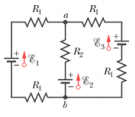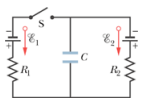A 0.25-µF capacitor is connected to a 400-V battery. Find the charge on the capacitor.
1.0 × 10−4 C
A wire carries a steady current of 0.1 A over a period of 20 s. What total charge passes through the wire?
2 C
What is Kirchhoff's 1st equation for this junction?

I1 + I2 + I3 = 0
The two ends of a 3 Ω resistor are connected to a 9 V battery. What is the total power delivered by the battery to the circuit?
27 W
A car goes around a curve of radius 60 m at a constant speed of 15 m/s. What is the centripetal acceleration of the car?
3.75 m/s2
Four identical 1 mF capacitors are connected. What is the least possible capacitance of the combination?
1/4 mF
A simple circuit consists of a 2 MΩ resistor that's connected to a 9V battery. How much power is dissipated by the resistor?
4 x 10-5 W
What is the current through the 8-Ω resistor?

1.5 A
Two resistors of values 6.0 and 12.0 Ω are connected in parallel. This combination in turn is hooked in series with a 4.0-Ω resistor and a 24-V battery. What is the current in the 6-Ω resistor?
2.0 A
A solid block is attached to an ideal spring horizontally with a relaxed length of 30.0 cm. To set the system into motion, the spring is stretched to a length of 35.0 cm and then released. The system oscillates with simple harmonic motion as the block slides back and forth across the frictionless surface, reaching a maximum kinetic energy of 2.5 J. Determine the spring constant of the spring.
2000 N/m
In the figure, both parallel-plate capacitors are initially uncharged. How much charge is stored in both parallel-plate capacitors? One is filled with air, and the other is filled with a dielectric for which κ = 3.00; both capacitors have a plate area of 5.00 × 10−3 m2 and a plate separation of 2.00 mm. The emf of the battery is 12 V.

1.06 x 10-9 C
A 0.20-m-long metal rod has a radius of 1.0 cm and a resistance of 3.2 x 10-5 Ω. What is the resistivity of the metal?
5.0 x 10-8 Ω*m
What is the magnitude of the current in the 20-Ω resistor?

0.50 A
In the circuit segment shown if I = 7 mA and Q = 50 µC, what is the potential difference, VA − VB?

-20 V

A ball of mass m is moving with speed v towards another ball of mass m attached to point P by a light rod, as shown in the figure above. The two balls stick together. Their angular speed immediately after the collision is...
v//2l
In the figure, the battery has a potential difference of V = 10.0 V and the five capacitors each have a capacitance of 10.0 μF. What is the charge on capacitor 2 (C2)?

20 μC
If 5.0 x 1021 electrons pass through a 20-ohm resistor in 10 min, what is the potential difference across the resistor?
27 V
In the figure, the resistances are R1 = 1 Ω and R2 = 2 Ω, and the ideal batteries have emfs ε1 = 2 V and ε2 = ε3 = 4 V. What are the size and direction of the current in battery 3?

0.33 A, up
A 15 kΩ resistor and a capacitor are connected in series, and then a 12 V potential difference is suddenly applied across them. The potential difference across the capacitor rises to 5 V in 1.3 μs. Calculate the time constant of the circuit.
2.41 microseconds
The velocity of an object of mass m m varies with time according to the equation v(t)=ct, where c is a constant. What is the instantaneous power delivered at time t?
mc^2t
The figure shows a parallel-plate capacitor with a plate area A = 5.56 cm2 and separation d = 5.56 mm. The left half of the gap is filled with material of dielectric constant κ1 = 7; the right half is filled with material of dielectric constant κ2 = 12. What is the capacitance?

8.41 x 10-12 F
An 18.0 W device has 9.00 V across it. How much charge goes through the device in 4.00 h?
2.88 x 104 C
Find i5.
i5= 7.5 A
The circuit shows a capacitor, two ideal batteries, two resistors, and a switch S. Initially S has been open for a long time. If it is then closed for a long time, what is the change in the charge on the capacitor? Assume C = 10 µF, ε1 = 1 V, ε2 = 3 V, R1 = 0.2 Ω and R2 = 0.4 Ω.

-13 μC
Two trains depart from one station, one going north at 30.00 miles per hour, and another going west, steadily accelerating with a rate of 0.3333 mph per minute. How many minutes after departure would the two trains be 50.00 miles apart?
90 minutes